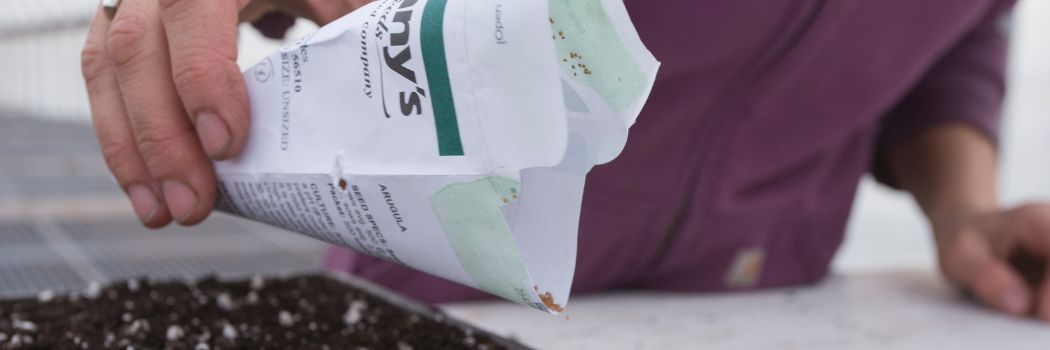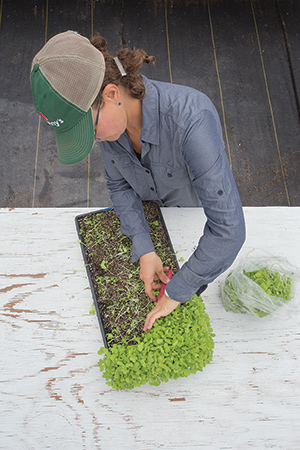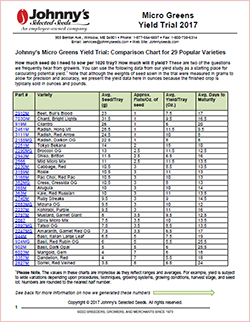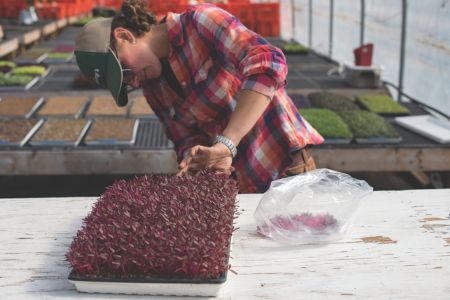- Video: Mild Micro Mix | Exclusively from Johnny's
- Microgreens Yield Data Trial | Summary, Materials & Methods, Findings & Discussion
- Microgreens Yield Data Trial | Table of RAW DATA (XLSX)
- Microgreens Yield Data Trial | Table of Averages for Each Variety | Tech Sheet (PDF)
- Costs & Materials Calculator | Microgreens & Seedling Bench for High Tunnel Installation
- Growing Microgreens Year-Round for Profit | Johnny's Selected Seeds
- Microgreens Production Fundamentals | Johnny's Webinar Series
- Microgreens | Key Growing Information
- Growing Microgreens at Home With Niki Jabbour
- Deluxe LED Microgreens Starter Kit Instructions | Tech Sheet (PDF)
- Video: 'Confetti Radish' Micro Mix | Exclusively from Johnny's
- Microgreens Production | Tech Sheet (PDF)
- Webinar Slide Deck | Microgreens Production Fundamentals | PDF
- Video: Microgreens Production & ROI, with Thomas Macy
- 12 Best Microgreens for Beginner Growers | Easy Choices to Get You Started from Johnny's Research Team
- Deluxe Microgreens Starter Kit Instructions | Tech Sheet (PDF)
- Basic Microgreens Starter Kit Instructions | Tech Sheet (PDF)
- Video: 'Rainbow Sprinkles' MicroMix | Exclusively from Johnny's
- Salad Mixes & Microgreens Mixes | 2-pp Spec Sheet (PDF)
- Microgreens Comparison Chart (PDF)
- Microgreens Brochure | An Overview of Growing, Harvesting & Marketing Basics | Printable 4-pp PDF
- Video: Microgreens Production Fundamentals | Webinar Recording
Johnny's Microgreens Yield Data Trial: Seed Density & Yield per Tray for 29 Varieties
Background
Our sales team receives all kinds of questions about microgreens: colors, sizes, growth rates, flavor… But among the most challenging to answer are, "How much seed should I sow, and how much will it yield?" These were the questions we set out to answer as we designed and conducted our 2017 Microgreens Yield Data Trial.
We know that there are many factors that come into play when evaluating microgreens yield. The two most obvious are seeding density and plant size at harvest (days to maturity). Even small changes to these factors can alter yield quantities. Then add natural vs. supplemental light, inside growing vs. greenhouse growing, seasonal shifts, variations in equipment and materials, and you quickly realize that the yield data from one person's growing system are unlikely to translate perfectly to another person's growing system.
Because of the many contributing variables to microgreens yield, we wanted to provide as many details as possible about our trial and the data that we collected.
Materials & Methods
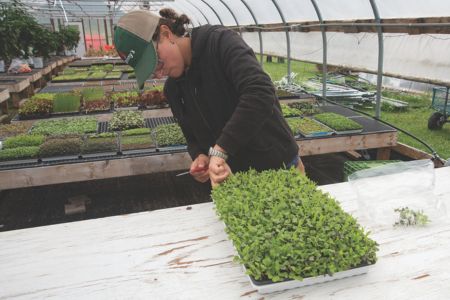
Harvesting Mild Micro Mix
Our micro mixes are carefully curated combinations developed for easy production of delicious, clean, colorful, reliably uniform stands.
In early September we set up a trial in a greenhouse designed to be completed by November 1, before the days got too short and the weather got too cold.
Supplemental heat was provided in the greenhouse during the last week of the trial, to keep the nighttime temperatures above freezing.
We chose 29 popular microgreens varieties and seeded them each at least 3 times, in order to capture a variety of information (including relative effect of day length on days to maturity and seeds sown/yield).
Each 1020 flat was filled with Johnny's Germination Mix and seeded by eye, weighing the seed packet before and after seeding to determine the exact quantity of seed used per flat.
Each variety was harvested at its first-true-leaf stage. Since this is one of the places where systems can produce differing results, we photographed each variety during one of its harvests so you can compare the appearance to your own desired size at harvest. These photos are posted on the product description pages for each of the 29 individual varieties we trialed. There are links to all 29 varieties from both the seed density and average yield chart and the raw data table, as described below.
Summary of Results
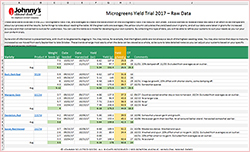
Raw Data Table (XLS)
This downloadable spreadsheet can be used as a template to track the results of your own trials and production variables.
Comparison Chart of Averages + Table of Raw Data
For each variety, we provide data on:
- Seeding density
- Yield per tray
- Days to maturity
For the purposes of summarizing our results, we offer our data in two forms: averages and raw.
- Averages. For those who want a general estimate of yields, we show averages in our Microgreens Yield Trial • Comparison Chart of Average Yield Per Tray & Seed Density (PDF).
- Raw. For those who want to take a deeper dive into our numbers, we show more detailed data in our Microgreens Yield Trial • Table of Raw Data (XLS).
Some interesting points from that raw data did not make it into the Yield Trial Comparison Chart of Averages, and will be discussed below.
Discussion
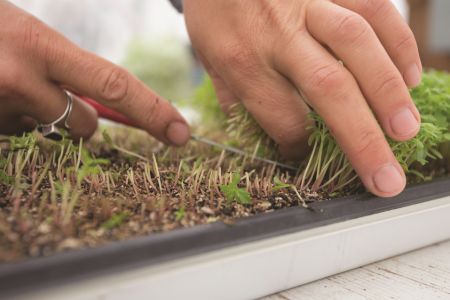
Harvesting 'Gem' Marigold
We found yield to be significantly increased when we allowed this variety to grow a day or two longer beyond development of its first set of true leaves, allowing time for the second set to emerge, before harvesting.
Much of the data gathered were unsurprising.
- Many of the brassicas, like Broccoli, 'Red Russian' Kale, 'Rosie' Pac Choi, and the Mild Micro Mix all yielded similar amounts per flat.
- 'Britton' Shiso, which has a larger seed than many herbs, was seeded at about the same density as a brassica.
- The basil microgreen varieties were all seeded at a similar density, but yielded different totals, mostly due to differences in stem length between varieties, and the purple basils took much longer to reach maturity.
Some of the data, however, were surprising.
- Some varieties, like Purple Kohlrabi, took much longer than expected to develop that first true leaf.
- Others, like 'Gem' Marigold, developed them rather quickly, but the yield could be increased dramatically by waiting an additional day or two to harvest before the second set of true leaves emerged.
- 'Garnet Red' Amaranth is quite small, so it's advisable to wait for the second true leaf to emerge, especially if you sow your seeds as thickly as we did. There seemed to be an understory in our flats that grew somewhat slower, and a few days were added to give these individuals a chance to catch up.
Conclusion
The data collected in this trial are intended for use as a jumping-off point. The averages provide rough numbers for you to work with, and the raw data sheet provides a template for further trialing on your own. Try some of these seeding rates, and see how they work for you. Want a larger plant? Use a bit less seed and wait a few more days. Want to harvest at the cotyledon stage? Sow more thickly and harvest earlier. Always be sure to provide sufficient air flow and appropriate temperatures to support your plants.
One important takeaway from the trial is the importance of taking good notes. To replicate or alter the results of any given seeding, you need to be able to see clearly what was done before. Feel free to use our spreadsheet as a template. Decide what information you want to collect, and be sure to include a comments column so you can record anything interesting that you encounter along the way. In this way, trends will emerge that will help you fine-tune your operation and become as profitable as possible.
Learn More
Growing Information
Variety Selection


